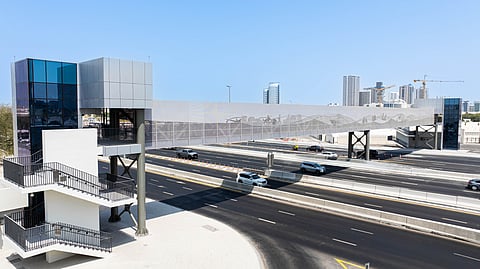Walk this way: RTA launches new bridges to boost pedestrian safety
Two major pedestrian bridges open in Dubai to make city safer, greener, and more walkable

Dubai: Dubai’s Roads and Transport Authority (RTA) has unveiled two new pedestrian bridges on Sheikh Rashid Street and Al Mina Street under the Al Shindagha Corridor Improvement Project, while also fast-tracking the construction of six pedestrian and cyclist bridges across the city’s key thoroughfares.
Five of these new crossings are set to open by the end of this year, with a sixth scheduled for completion in the first quarter of 2027.
RTA has also announced plans to build 23 more pedestrian bridges by 2030, further expanding a network that has grown from 26 bridges in 2006 to 177 in 2024 — a 581% increase.
Commitment to safety
Mattar Al Tayer, Director General, Chairman of the Board of Executive Directors of Dubai’s Roads and Transport Authority, said: “RTA’s drive to deliver pedestrian bridges reflects the directives of the leadership to enhance road safety, provide a safe and sustainable mobility environment for all road users, and transform Dubai into a pedestrian and cyclist-friendly city. It also supports the city’s quality of life agenda.”
“The pedestrian bridges already in place, together with those planned, form a network linking residential areas across Dubai with key attractions, thereby encouraging residents to adopt sustainable individual mobility means for the first and last-mile journeys. The number of pedestrian bridges and underpasses grew from 26 in 2006 to 177 by the end of 2024, marking an increase of 581%. Under the current plan, RTA will construct 23 additional pedestrian bridges by 2030, with implementation guided by detailed field studies. These studies take into account population density, integration with land uses, tourism and economic attractions, and public transport stations to enhance traffic flow and facilitate safe pedestrian and cyclist movement across the city’s streets.”
Drop in fatalities
Al Tayer added: “RTA’s efforts in enhancing road safety and integrating infrastructure have contributed to a decline in pedestrian fatalities and accidents, from 9.5 deaths per 100,000 people in 2007 to 0.3 deaths in 2024, a reduction of 97%. RTA’s efforts in developing pedestrian crossings have also raised pedestrian satisfaction levels in Dubai to 88%, while pedestrian trips have increased from 307 million in 2023 to 326 million in 2024, a growth of 6%. In addition, cycling trips have risen from 44 million in 2023 to 46.6 million in 2024, reflecting a 5% increase.”
Towards zero fatalities
Al Tayer continued: “RTA places the highest priority on pedestrian safety as one of the core elements of a safe and sustainable transport system in Dubai. The construction of pedestrian and cyclist bridges is in line with Dubai’s Traffic Safety Strategy, which aims to achieve Zero Fatalities and position Dubai among the world’s leading cities in road safety. RTA continues to construct more pedestrian bridges in line with the highest international standards of design and construction, while also incorporating creative and aesthetic elements. These bridges are equipped with the latest global systems, including electromechanical systems, fire alarm and firefighting systems, remote monitoring, and other safety and security requirements. Some bridges are also fitted with dedicated paths and bike racks.”
Landmark new crossings
The newly opened Sheikh Rashid Street bridge measures 91 metres long, while the Al Mina Street bridge spans 109 metres. Both are 3.4 metres wide and 6.5 metres high, and feature lifts, staircases, fire safety systems, and remote monitoring rooms.
Meanwhile, six additional pedestrian and cyclist bridges are advancing rapidly:
Sheikh Zayed Road bridge (528m) and Al Khail Road bridge (501m) — striking architectural designs inspired by interwoven lines and sunlight, linking Al Sufouh to Dubai Hills via Dubai Internet City, Al Barsha Heights and Al Barsha 3.
Al Manara Street bridge (45m) — located in the Al Quoz Creative Zone, complementing the area’s design identity.
Sheikh Mohammed bin Zayed Road bridge (554m) — at the Tunis Street junction, linking Muhaisnah 1 and Al Twar towards Al Mamzar Beach.
Dubai—Al Ain Road bridge (730m) — linking Wadi Al Safa 4 (Liwan) with Nadd Hessa (Dubai Silicon Oasis).
Al Sukook Street bridge (44m) — part of the Future Street Improvement Project in Dubai’s Central Business District, set for completion in 2027.
Expanding the network
RTA has also mapped out nine more pedestrian bridges by 2028, including crossings near Coca-Cola Arena, Business Bay, and the Burj Khalifa area, plus six bridges along Al Asayel Street.
With these projects, Dubai is rapidly transforming into one of the most pedestrian- and cyclist-friendly cities in the world, aligning with its vision to achieve zero road fatalities while enhancing the city’s quality of life.
Sign up for the Daily Briefing
Get the latest news and updates straight to your inbox



